“Everyone who is responsible for significant cultural assets will be thinking about how they might prevent an incident like the Notre Dame fire happening,” said Peter Aiers, chief executive of the Churches Conservation Trust in London. “There will be many reviews of policy, procedure and practice undertaken in the very near future, I expect.”
But “there’s no magic bullet, there’s always a risk,” Mr. Aiers said.
He noted two fires involving important medieval structures in England: the York Minster fire in 1984, probably caused by a lightning strike to the church’s roof; and the Windsor Castle fire in 1992, caused by a spotlight left against a curtain. The 15-hour fire damaged or destroyed more than 100 rooms, one-fifth of the castle. Rebuilding took five years.
Late Monday, a fire ravaged Notre Dame, which dates to the 12th century and is France’s most-visited monument. The cathedral had been undergoing restoration work when the fire broke out, which increases the chance of fires and other accidents because of the flammable materials and heat-generating equipment used, said Mr. Aiers and other experts. The Paris prosecutor’s office is investigating the fire as an accident.
The fire destroyed two-thirds of the wooden frame that held up a lead-plated roof and caused the collapse of the church’s main spire. Many of the most important relics housed in the church were saved, though officials were still assessing the situation Tuesday and it wasn’t clear how much damage the inside of the church had sustained. Smoke and water had damaged several large paintings that were too big to be removed, according to French media
Spain’s culture minister, José Guirao, told RNE radio, “When there is restoration work one has to be extremely careful because someone’s carelessness can provoke a tragedy. 100% security doesn’t exist for monuments, or anything.”
In light of the Notre Dame fire, the Spanish culture ministry will hold an extraordinary meeting on April 26 to discuss plans for safeguarding the country’s national monuments.
Italy has an action plan in place for protecting all its historic buildings and it is too early to say how that might evolve following the Notre Dame fire, said a spokesman for the country’s cultural ministry.
“While you can’t cancel out all risks, more could have been done and now Notre Dame has paid the price to save other monuments in Europe,” said Giuliana Cardani, an architect and professor in the engineering department of Milan’s Polytechnic University specializing in building restorations. “It’s sad, but sometimes you need to have something terrible happen for there to be better controls and security.”
A specific plan for guaranteeing security against fire and other hazards during restoration work must be developed for every building, Ms. Cardani said.
Some of Notre Dame’s defining features made it particularly vulnerable to the type of fire that swept through the structure on Monday. The cathedral is famed for its high external walls, vast stained glass windows and stone gargoyles, all of which were made possible by the medieval innovation of flying buttresses—which help to support the heavy structure from the outside.
The vast, airy inside of the church allowed fire to spread unabated for some time before firefighters could intervene effectively.
It is still too early to assess the speed of the French firefighters’ response to the fire, which broke out just before 7 p.m. local time on Monday.
“It will take at least 15 years and more than 1 billion euros to renovate Notre Dame,” said Robert Read, an underwriter who heads the art and private client division of London-based insurer Hiscox.
“It’s going to be a monster job,” said Mr. Read, who based his estimates in part on renovations planned for London’s Houses of Parliament.
Restorers are unlikely to use flame-retardant paint on surfaces such as the roof of Notre Dame, Mr. Aiers said, since the benefits would be marginal compared with the financial cost.
“If you’ve got highly sculpted pieces of medieval wood, that would change the profile” and color of the carving, Mr. Aiers said, violating the aesthetics of the building.
It would be impossible to rebuild the roof in the same way as the original, Bertrand de Feydeau, vice president of the conservation group Fondation du Patrimoine, told French RMC television, because France no longer produces large enough timber. “We will not be able to reproduce the framing [of the roof] made with trees that we can’t even find in our forests today.”
Each beam of the frame came from a different oak tree, many of which would have been close to 400 years old when they were cut down in the 12th century, according to Notre Dame Cathedral’s website.












